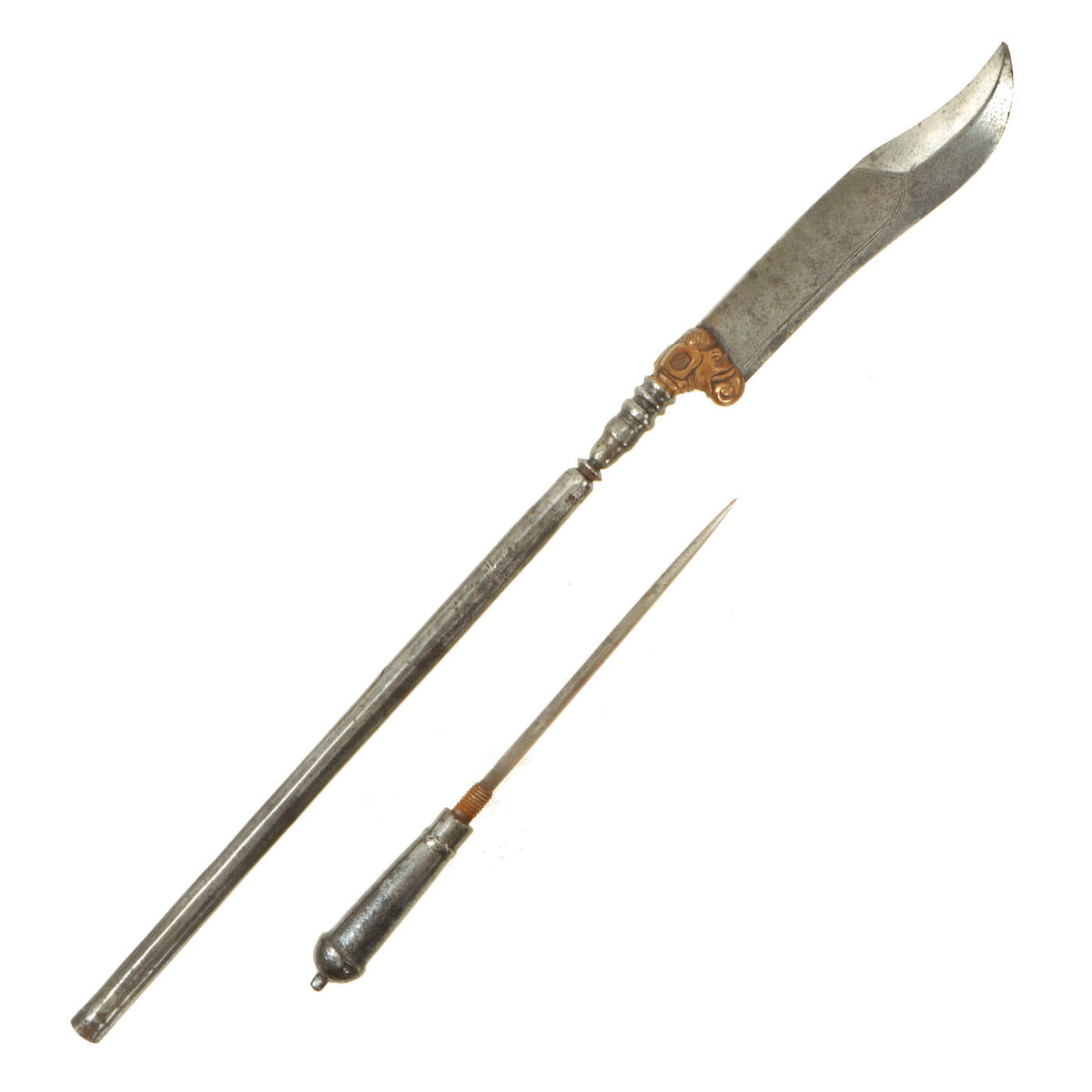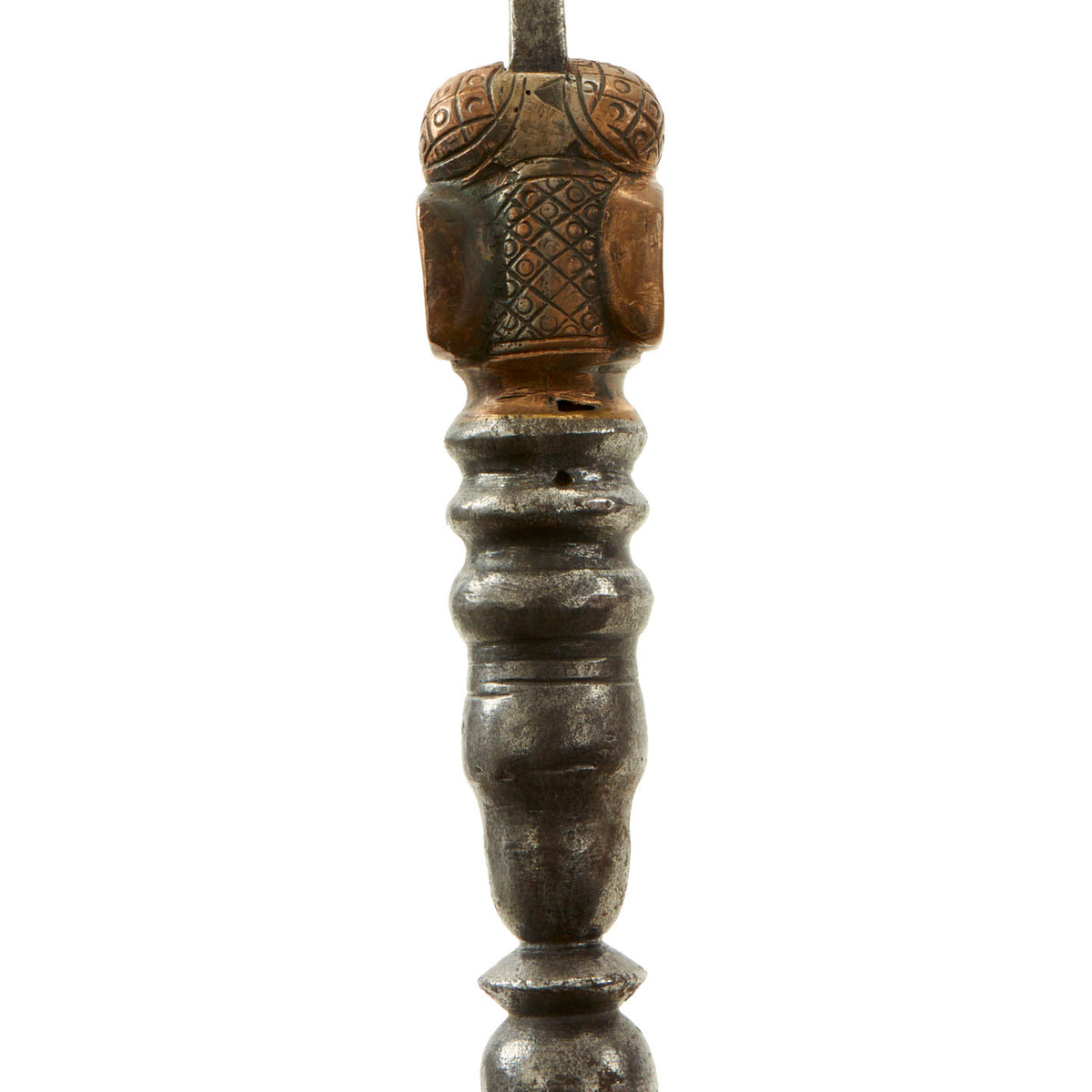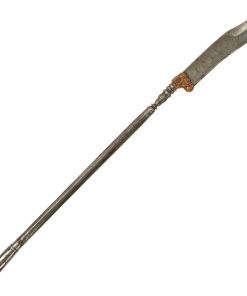Original 18th Century Indian Bhuj Fighting “Axe-Knife” with Wootz Steel Warhead & Hidden Pommel Spike Dagger – circa 1750 Original Items
$ 1.995,00 $ 498,75
Original Item: One of a Kind. This is a most unusual weapon, seldom encountered on the collector’s market. This is known as a “BHUJ” and originated with the Gujarat and Sindh speaking regions in Western India. They were used by armored soldiers on horseback, and are quite formidable.
Our example measures 37 1/2″ in overall length, and has a heavy iron shaft, which gives it quite a bit of weight. This is topped with an extraordinary BOWIE bladed warhead made from “WOOTZ” steel, and early laminated crucible steel similar to “Damascus Steel”. Like most, the base of the warhead is decorated with an elephant’s head fitting at the rear end, which is why these were often called “elephant knives”. The pommel end of the shaft also houses a 15″ long chainmail piercing dagger with a 9” square spike blade screwed into the hilt. Truly a terrifying weapon.
Dating possibly to 1750 these were still in use 100 years later. Very unusual and rare!
Specifications:
Blade Length (Warhead): 9 ¾”
Blade Style (Warhead): Clip-point “Bowie”
Blade Length (Dagger): 9”
Blade Style (Dagger: Square Spike.
Overall Length (dagger): 15”
Overall Length (assembled): 37 ½”
A bhuj is a type of knife or dagger from Sindh and Gujarat. It is commonly called an axe-knife, because the blade is fixed onto an axe-like haft. The weapon takes its name from the city of Bhuj in the Kutch district of the state of Gujarat, where it originated, though it may have also originated in Sindh. The bhuj is short, broad, stout, and heavy, with a mild curve. It often sports an engraved and gilded mount, inlaid haft and decorated knob. This knob is typically a stylized elephant head, giving the weapon the nickname elephant knife. The short re-curved blade measures 7-10 inches long, and its copper sheath makes the weapon 20 inches long in total. It is mostly single-edged, except for a slight rear edge at the tip. The blade is mounted at a right angle to a metal haft in a manner similar to a long axe. The haft is sometimes hollow, concealing another small stiletto-like dagger. The weapon is similar to the Punjabi gandasa or the European glaive. The weapon was popular among the Sindhi cavalry of the Soomra and Samma dynasties of Sindh.
Fast Shipping with Professional Packaging
Thanks to our longstanding association with UPS FedEx DHL, and other major international carriers, we are able to provide a range of shipping options. Our warehouse staff is expertly trained and will wrap your products according to our exact and precise specifications. Prior to shipping, your goods will be thoroughly examined and securely secured. We ship to thousands clients each day across multiple countries. This shows how we're dedicated to be the largest retailer on the internet. Warehouses and distribution centres can be located throughout Europe as well as the USA.
Note: Orders with more than one item will be assigned a processing date depending on the item.
Before shipping before shipping, we'll conduct a thorough inspection of the items you have ordered. Today, the majority of orders will be delivered within 48 hours. The delivery time will be between 3-7 days.
Returns
The stock is dynamic and we cannot completely manage it because multiple stakeholders are involved, including our factory and warehouse. So the actual stock may alter at any time. It's possible that you may not receive your order once the order has been made.
Our policy is valid for a period of 30 days. If you don't receive the product within 30 days, we are not able to issue a refund or an exchange.
You can only return an item if it is unused and in the same state as the day you received it. You must have the item in its original packaging.
Related products
Uncategorized
Uncategorized
Uncategorized
Uncategorized
Australian WWII Owen MK1 Machine Carbine SMG Custom Fabricated Replica with Sling Original Items
Uncategorized
Uncategorized
Uncategorized
Uncategorized
Uncategorized
Angolan Rebel 1970s era 60mm Inert Display Mortar from Angolan Civil War Original Items
Uncategorized
Uncategorized
Uncategorized
Uncategorized
Armored Burgonet Helmet & Polearm from Scottish Castle Leith Hall Circa 1700 Original Items
Uncategorized
Uncategorized
Uncategorized
Uncategorized
Uncategorized
Band of Brothers ORIGINAL GERMAN WWII Le. F.H. 18 10.5cm ARTILLERY PIECE Original Items
Uncategorized













































































